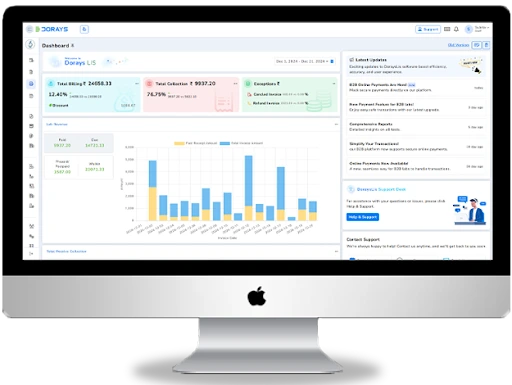
Liver Function Test (LFT) Report Format
What is Liver Function Test (LFT)?
A Liver Function Test (LFT) is a blood test used to evaluate the health and different functioning activities of the liver. It assesses the concentration of liver enzymes, proteins, and other components within a person's blood which the liver produces or releases following cell damage. It assists in the identification of liver conditions like hepatitis, cirrhosis, liver’s fatty infiltrative disease, and liver dysfunctions, so the physician may estimate the degree of liver injury and track the recovery process.
What is Liver Function Test (LFT) Report Format?
LFT report is one of the most comprehensive documents in the form of a report which describes the outcome of blood investigation aimed at assessing the degree of liver damage, inflammation and overall health status of the liver. It gives a complete picture of different liver enzymes, proteins, and waste materials relevant to the liver in question.
The test is often ordered when a patient presents with clinical manifestations of liver pathology such as jaundice, right upper quadrant pain (RUQP), darkened urine, extreme lethargy, or simply for a periodic head-to-toe assessment.
Tests Included in LFT Report
Test | Description |
Alanine Aminotransferase (ALT) | An enzyme found in the liver, elevated levels may indicate liver damage. |
Aspartate Aminotransferase (AST) | An enzyme found in liver and heart tissue, elevated levels suggest liver damage. |
Alkaline Phosphatase (ALP) | An enzyme linked to the bile ducts; high levels may indicate bile duct blockage or liver disease. |
Gamma-Glutamyl Transferase (GGT) | An enzyme found in the liver; elevated levels often indicate bile duct problems or alcohol-related liver damage. |
Bilirubin (Total and Direct) | A waste product from red blood cell breakdown; high levels can indicate liver dysfunction. |
Albumin | A protein produced by the liver; low levels can suggest liver disease or cirrhosis. |
Total Protein | Measures all proteins in the blood; low levels may indicate liver damage or malnutrition. |
Key Parts of a LFT Report
Part | Description |
ALT (Alanine Aminotransferase) | Indicator of liver damage, particularly useful for diagnosing hepatitis. |
AST (Aspartate Aminotransferase) | Elevated levels can suggest liver or muscle damage, including liver diseases. |
ALP (Alkaline Phosphatase) | High levels may indicate obstruction in the bile ducts or liver diseases. |
GGT (Gamma-Glutamyl Transferase) | Helps identify liver or bile duct disease and alcohol-related liver damage. |
Bilirubin | High bilirubin levels can indicate jaundice or liver dysfunction. |
Albumin | Reflects liver’s ability to produce proteins; low levels signal liver damage. |
Total Protein | Measures overall protein levels, giving a general picture of liver health. |
Normal Ranges for a LFT Report
Test | Normal Range |
ALT (Alanine Aminotransferase) | 7-56 U/L (units per liter) |
AST (Aspartate Aminotransferase) | 10-40 U/L |
ALP (Alkaline Phosphatase) | 44-147 U/L |
GGT (Gamma-Glutamyl Transferase) | 9-48 U/L |
Bilirubin (Total) | 0.1-1.2 mg/dL |
Bilirubin (Direct) | 0-0.3 mg/dL |
Albumin | 3.5-5.0 g/dL |
Total Protein | 6.0-8.3 g/dL |
Parameters to Consider in a LFT Report
Parameter | Interpretation |
ALT (Alanine Aminotransferase) | High levels may indicate acute liver damage, particularly hepatitis. |
AST (Aspartate Aminotransferase) | Elevated levels suggest liver or heart damage; used to differentiate types of liver disease. |
ALP (Alkaline Phosphatase) | High levels may suggest bile duct obstruction, liver disease, or bone disorders. |
GGT (Gamma-Glutamyl Transferase) | High GGT levels often correlate with alcohol-related liver disease or bile duct problems. |
Bilirubin (Total and Direct) | Elevated bilirubin levels can indicate liver disease or dysfunction, leading to jaundice. |
Albumin | Low levels may suggest chronic liver disease, cirrhosis, or malnutrition. |
Total Protein | Low protein levels can indicate liver disease, kidney issues, or malnutrition. |
Guidelines for Liver Function Test Report Format
Proposed Structure of a Liver Function Test Report
Total Scores : Add every single score in numbers indicating each test.
Results Reference : Make available sufficient benchmark values for every test to note disparities swiftly.
Interpretation/Comments : Document any input comments received alongside the normal, abnormal, or borderline definition.
Patient : Document a clientele demographic profile which should detail the patient's history, medications, gender, and age because those impact the liver tests.
Date & Chronology : Specifically outline the date of the test for future reference and follow up.
What Do the Results Mean?
Liver Function Test results may assist in establishing a diagnosis of liver diseases or assessing liver damage.
High ALT and AST : May mean inflammation or damage of the liver which could stem from hepatitis or liver damage due to alcohol intake
Elevated ALP : Generally indicates problems with bile ducts or liver disease.
High Bilirubin : Points towards liver dysfunction, jaundice or even more serious conditions.
Low Albumin and Total Protein : Indicators of failure of the liver or chronic liver disease.
Download LFT Report Sample
Download LFT Report Sample Here
LFT Report Interpretation
Test | Interpretation |
ALT (Alanine Aminotransferase) | High levels may indicate acute liver conditions such as hepatitis or fatty liver. |
AST (Aspartate Aminotransferase) | High AST levels are indicative of liver damage but can also indicate heart or muscle injury. |
ALP (Alkaline Phosphatase) | Elevated ALP often points to bile duct obstruction or liver disease. |
GGT (Gamma-Glutamyl Transferase) | Increased GGT can suggest alcohol-related liver disease or bile duct abnormalities. |
Bilirubin (Total) | High bilirubin levels suggest a buildup of waste in the bloodstream, indicating liver issues. |
Albumin | Low albumin indicates that the liver is not producing enough protein, often seen in cirrhosis. |
Total Protein | A decrease in total protein levels could signal liver dysfunction or other health conditions. |

Effortless Lab Management Starts Here!
Experience the future of lab operations. One click to revolutionize your lab.


